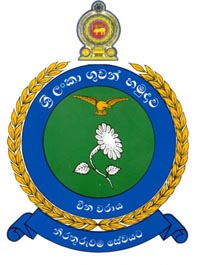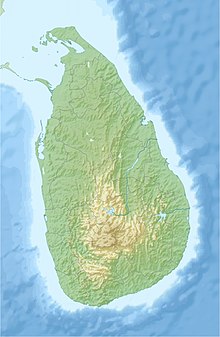| China Bay Airport சீனக்குடா விமான நிலையம் චීන වරාය ගුවන්තොටුපළ | |||||||||||
|---|---|---|---|---|---|---|---|---|---|---|---|
 SLAF China Bay crest SLAF China Bay crest | |||||||||||
| Summary | |||||||||||
| Airport type | Military/Public | ||||||||||
| Owner | Government of Sri Lanka | ||||||||||
| Operator | Sri Lanka Air Force | ||||||||||
| Serves | Trincomalee | ||||||||||
| Location | China Bay, Sri Lanka | ||||||||||
| Commander | H. M. S. K. Kotakadeniya | ||||||||||
| Elevation AMSL | 2 m / 7 ft | ||||||||||
| Coordinates | 08°32′22.40″N 81°10′54.70″E / 8.5395556°N 81.1818611°E / 8.5395556; 81.1818611 | ||||||||||
| Map | |||||||||||
 | |||||||||||
| Runways | |||||||||||
| |||||||||||
China Bay Airport (Tamil: சீனக்குடா விமான நிலையம், romanized: Cīṉakkuṭā Vimāṉa Nilaiyam; Sinhala: චීන වරාය ගුවන්තොටුපළ, romanized: Cīna Varāya Guvantoṭupaḷa; (IATA: TRR, ICAO: VCCT)) is an air force base and domestic airport in China Bay in eastern Sri Lanka. Located approximately 7 km (4.3 miles) south west of the city of Trincomalee, the airport is also known as Trincomalee Airport and SLAF China Bay.
Originally built by the British and known as RAF China Bay, it was transferred to the Royal Ceylonese Air Force which later became the Sri Lanka Air Force.
History
During the 1920s the British built an airfield in China Bay in eastern Ceylon. The Royal Air Force (RAF) established an airfield called RAF Station China Bay in March 1942 which operated Consolidated Liberator bombers, Hawker Hurricane & Supermarine Spitfire fighters, Consolidated Catalina & Short Sunderland flying boats during its lifetime.
A number of RAF squadrons and other units were stationed at the airfield during and immediately after the war:
- No. 17 Squadron RAF between 28 August 1943 and 14 January 1944 with the Hurricane IIC
- detachment of No. 159 Squadron RAF between July 1944 and June 1945 with the Liberator V
- detachment of No. 205 Squadron RAF between July 1942 and September 1945 with the Catalina then again between September 149 and March 1958 with the Sunderland GR.5
- detachment of No. 240 Squadron RAF between July 1942 and July 1945 with the Catalina then again between July 1945 and January 1946 with the Sunderland V
- detachment of No. 258 Squadron RAF between March 1942 and February 1943 with the Hurricane
- No. 261 Squadron RAF between 6 March 1942 and 14 January 1943 with the Hurricane I
- No. 273 Squadron RAF between 15 February and 1 August 1943 with the Hurricane IIB
- No. 321 (Dutch) Squadron RAF reformed here on 15 August 1942 with the Catalina, staying until October 1945
- detachment of No. 357 Squadron RAF during February 1944 with the Liberator III
- detachment of No. 684 Squadron RAF between May 1944 and May 1945
- Advanced Flying Boat Base between 1 October 1950 and 30 November 1957
- detachment of No. 5 Air Sea Rescue Flight between April and June 1945
- No. 235 Air-Sea Rescue Unit between 9 October 1943 and 12 October 1945
- No. 1352 Air Sea Rescue Flight during September 1945
- No. 984 (Balloon) Squadron between 10 January and 31 December 1944
A number of Fleet Air Arm squadrons also used China Bay:
- 733, 788, 791, 800, 802, 803, 804, 806, 807, 808, 809, 810, 812, 814, 817, 818, 822, 824, 828, 830, 831, 832, 834, 837, 845, 847, 851, 854, 879, 880, 888, 896, 898, 1700, 1830, 1831, 1833, 1839, 1844 and 1851
The airfield was bombed by the Japanese on 9 April 1942 during World War II. The airfield was upgraded to accommodate the United States Army Air Forces (USAAF) Boeing B-29 Superfortress over the first half of 1944. After these upgrades were complete it was used to stage the B-29 attack force for the unsuccessful Operation Boomerang raid on oil refineries at Palembang, Dutch East Indies in August 1944.
After independence, the British maintained two military airfields in Ceylon, the RAF station at Katunayake and the Royal Navy base in Trincomalee, and camps at Diyatalawa. The naval base in Trincomalee included the airfield in China Bay. It was opened to civilian flights in 1952. All British military airfields/barracks and sites in the country were transferred and taken over by the Ceylonese government in November 1957. RAF China Bay became RCyAF China Bay. When Ceylon became the republic of Sri Lanka it became SLAF Base China Bay in May 1972. The base was turned into the Sri Lanka Air Force Academy in March 1976. The academy was made an air force base in January 1987 due to the civil war.
Airlines and destinations
Passenger
| Airlines | Destinations |
|---|---|
| Air Senok | Charter: Colombo–Ratmalana |
| Cinnamon Air | Colombo–Bandaranaike, Sigiriya |
| FitsAir | Charter: Colombo–Ratmalana, Jaffna |
| Helitours | Colombo–Ratmalana, Jaffna Charter: Hambantota-Mattala |
Cargo
| Airlines | Destinations |
|---|---|
| FitsAir | Colombo–Ratmalana |
Lodger Units
- No. 01 Flying Training Wing
- No. 06 Air Defence Radar Squadron
- No. 112 Surveillance Squadron
- No. 06 Air Defence Radar Squadron
Air Force Academy
The base houses the Sri Lanka Air Force Academy. Established in 1976, the academy is where the Sri Lanka Air Force conducts its initial officer training. Currently there are three lodger formations carrying out training:
- Combat Training School
- Junior Command & Staff College
- Non-Commissioned Officers Management School
References
Citations
- "VCCT TRINCOMALEE / China-bay". Aeronautical Information Services of Sri Lanka, Airport & Aviation Services. Archived from the original on 2013-12-14. Retrieved 2013-09-08.
- "TRR - Airport". Great Circle Mapper.
- ^ "History of Air Force Base China Bay". Sri Lanka Air Force. Archived from the original on 7 June 2008.
- "RAF Stations - C". Air of Authority: A History of RAF Organisation.
- Jefford 1988, p. 30.
- Jefford 1988, p. 63.
- Jefford 1988, p. 68.
- Jefford 1988, p. 76.
- Jefford 1988, p. 79.
- Jefford 1988, p. 80.
- Jefford 1988, p. 82.
- Jefford 1988, p. 86.
- Jefford 1988, p. 88.
- Jefford 1988, p. 105.
- Sturtivant & Hamlin 2007, p. 32.
- Sturtivant & Hamlin 2007, p. 53.
- Sturtivant & Hamlin 2007, p. 55.
- Sturtivant & Hamlin 2007, p. 119.
- Sturtivant & Hamlin 2007, p. 75.
- Sturtivant & Ballance 1994, p. 367.
- Devarajah, Lloyd Rajaratnam (11 April 2010). "Ceylon's Pearl Harbour attack". The Sunday Times (Sri Lanka).
- Wijenayaka, Walter (5 April 2011). "Bombing of Colombo during world war II". The Island (Sri Lanka).
- "Sri Lankan Aviation History". Ministry of Civil Aviation, Sri Lanka. Archived from the original on 2013-12-12.
- "Take over of Trincomalee a landmark event". The Sunday Times (Sri Lanka). 12 October 2008.
- "Air Force takes wing". The Sunday Times (Sri Lanka). 9 March 2008.
Bibliography
- Jefford, C. G. (1988). RAF Squadrons. A comprehensive record of the movement and equipment of all RAF squadrons and their antecedents since 1912. Shrewsbury, UK: Airlife Publishing. ISBN 1-85310-053-6.
- Sturtivant, Ray; Ballance, Theo (1994). The Squadrons of The Fleet Air Arm. Tonbridge, UK: Air-Britain (Historians). ISBN 0-85130-223-8.
- Sturtivant, Ray; Hamlin, John (2007). Royal Air Force flying training and support units since 1912. Tonbridge, UK: Air-Britain (Historians). ISBN 978-0851-3036-59.
External links
| Airports in Sri Lanka | |||||
|---|---|---|---|---|---|
| International |
| ||||
| Domestic | |||||
| Waterdromes |
| ||||
| Military | |||||
| Proposed Airport | |||||